 American Journal of Oper ations Research, 2011, 1, 284-292 doi:10.4236/ajor.2011.14033 Published Online December 2011 (http://www.SciRP.org/journal/ajor) Copyright © 2011 SciRes. AJOR DEA Models for the Efficiency Evaluation of System Composed of Parallel Subsystems Jinnian Wang*, Yongjun Li School of Management, University of Science and Technology of China, Hefei, China E-mail: *wjinnian@mail.ustc.edu.cn Received August 30, 2011; revised Septembe r 27, 2011; acc ept ed Oct ober 9, 2011 Abstract The perspective of internal structure of the decision making units (DMUs) was considered as the “black box” when employing data envelopment analysis (DEA) models. However, in the actual world there are always some DMUs that are composed of several sub-units or subsystems, each utilizes the same inputs to generate same outputs. Numerous instances can be listed, such as a firm with a few of plants. In this paper we present models that evaluated the efficiency of DMU which is comprised of same several parallel subsystems, the foremost contribution of our work is that we take the different importance of the subsystems into account in the model, which can be obviously distinguished to the existing DEA model. Secondly, since the alternative optimal multipliers may emerge in the model, the efficiency of each subsystem may be non-unique and we simultaneously develop models of efficiency decomposition for each subsystem. At last a case of technologi- cal innovation activities of each province in China is used as an example to state the models. Keywords: Data Envelopment Analysis, Parallel Subsystems, Efficiency Decomposition, Technological Innovation 1. Introduction A non-parametric mathematical programming, data en- velopment analysis (DEA), has been widely used in per- formance evaluation and benchmark [1]. Since the ap- pearance of first CCR model [2], a series of different DEA models, such as BCC [3], FG [4], ST [5] and so on, have been proposed in succession. The method has been proved to be an effective tool, due to its advantage that it does not premeditate the production function, the inter- mediate process of inputs convert to outputs was treat as a “black box” manipulation. Nevertheless, in the real world, it may be irrational for the efficiency evaluation of whole system when ignores its internal structure, especially which was composed of several subsystems. Scholars have committed to discuss the internal structure of the DMUs, a number of papers has done, such as two-stage model [6-9] of linear struc- ture; network DEA model [10-12] with complicated in- ternal structure. Moreover, system which is made up of several parallel subsystems have also been researched in many literatures, a model to measure the efficiency of multi-plant firms was proposed by Färe and Primont [13]; Yang [14] developed the so-called YMK model in meas- uring efficiencies of the production system with k inde- pendent subsystems. In addition, Castelli [15] present hierarchical structures of the DMU under appraisal. More recently, Kao [16] put forward a parallel DEA model which considers the operation of individual com- ponents to calculate the efficiency of the whole system. In this paper, we will investigate the system with sev- eral parallel subsystems and assume that the number of the subsystems is same, which can depict as Figure 1. Each subsystem uses the same inputs to produce the same outputs, and cross utilization does not exist, the total inputs and outputs of the overall system are consti- tuted by the sum of inputs and outputs of each subsystem. In summary, they are non-connatural in efficiency evaluation of whole system. However, to differentiate the above papers that assumed subsystems are equally im- portant to the overall system, this paper believes that the importance of each subsystem may be different to a sys- tem under evaluation. For example, for some given fix resource, if one subsystem was considered to be more important, then more resource may be allocated to it rather than others, here the importance degree can repre- sent by the volume of the inputs. Therefore, the different relative importance of each subsystem should be taking  285 J. N. WANG ET AL. Figure 1. A parallel system composed of same subsystems. into consideration in efficiency evaluation. After measuring the efficiency score of the overall system, each subsystem was also investigated. The me- thod of efficiency decomposition was applied to deter- mine the efficiency of each subsystem in this paper, and rest is organized as follows: Section 2 develops DEA models for measuring the efficiencies of the overall sys- tem as well as each subsystem. In Section 3, an example of technological innovation activities of each region in China was used to illustrate the models introduced in Section 2. Finally, Section 4 gives our conclusions. 2. DEA Models 2.1. Models for Measuring the Overall Parallel System To introduce the DEA model, suppose that there are a set of DMUs denoted by , each composes of same p parallel com- ponents or subsystems and each used the same inputs to generate the same outputs. The subsystem k of contains m inputs, denoted by n DMU DMU k ij DMU1, , jjn n n 1, , jj 1, , jj 1, , im and outputs, denoted by . The sums of 1, , k rj sYr 1, , k ij k ij p and 1, , k rj pYk are the whole inputs 1, , im and outputs of the jth parallel system, 1, ,Yrs rj namely 1 1, , pk ij ij k Xi m and 1 1, , pk rj rj k YYr s . Then, to any given DMU0, the efficiency of its subsystem 1, ,kk p can be cal- culated via a BCC model as following model (1). 00 1 0 0 1 max skk k rr krmkk ii i uY ek wX 0 1 1 0 s.t. 1 ,0,,,,free skkk rrj rmkk iij i kk k ir uY j wX wu ri (1) Here the optimal objective function value of model (2) was denoted as 01, , k ek p, which is the efficiency value of each subsystem. When we evaluate the performance of an overall par- allel system, its inputs and outputs used in each subsys- tem are connatural, respectively, so this paper believes the weights attached to the same inputs and outputs in both subsystems are same, respectively. Therefore we have: k ii ww , ,ik and , (2) k rr uu,rk The computation in (1) only considered each subsys- tem was equally. However, as we mentioned above, we believe that each subsystem may have different relative importance to a given DMU under evaluation. For ex- ample, if a company has two departments, sales depart- ment and production department, when the quantity sup- plied is more than quantity demanded, the manager of the company probable deemed that sales department is more relative important. Suppose that there are some given resources, such as human and fund, the manager may invest more resource in sales department rather than production department, it is obviously thought that the core activity of the company focus on marketing for the time being, if the two departments are treated as equal, the performance of the company was more impossible to become efficient. Therefore, the different relative impor- tance of the two departments should be considered in the model. If we denote the relative importance of subsystem k as 1, , kk p p, then can be set as follows: 1, , kk 0 1 0 1 , mk ii i km ii i wX k wX (3) The numerator and denominator in (3) denote the weighted gains of DMU0 from the subsystem k and the overall parallel system, respectively. Apparently, it finds that k increases if the subsystem k has more impor- tance in DMU0, and 1 1 p k k . Therefore, a following model can be used to evaluate the relative efficiency of an overall parallel system DMU0: Copyright © 2011 SciRes. AJOR 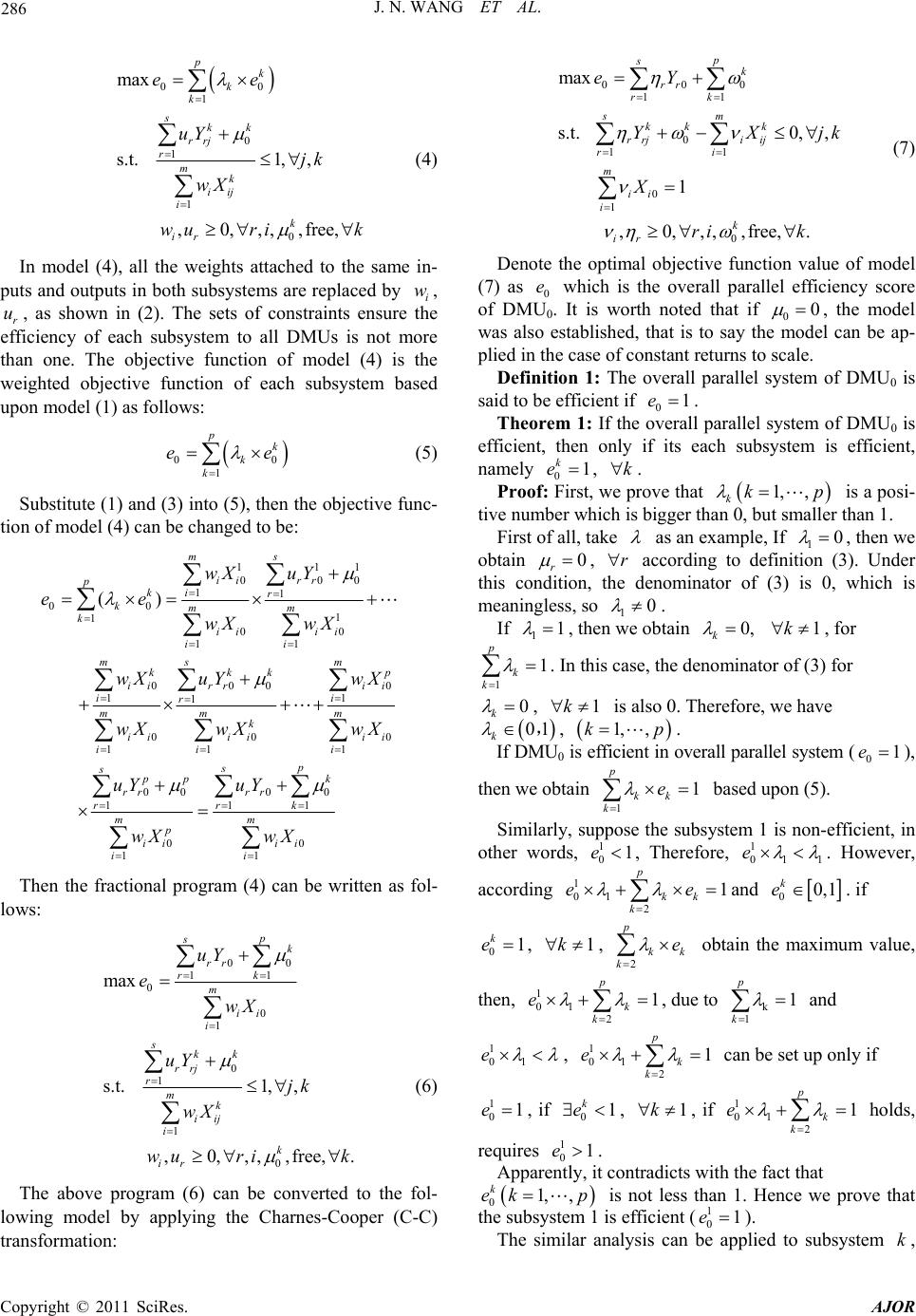 J. N. WANG ET AL. 286 00 1 0 1 1 0 max s.t. 1,, ,0,,,,free, pk k k skk rrj rmk iij i k ir ee uY jk wX wu rik (4) In model (4), all the weights attached to the same in- puts and outputs in both subsystems are replaced by i, r, as shown in (2). The sets of constraints ensure the efficiency of each subsystem to all DMUs is not more than one. The objective function of model (4) is the weighted objective function of each subsystem based upon model (1) as follows: w u 0 1 pk k k e 0 e (5) Substitute (1) and (3) into (5), then the objective func- tion of model (4) can be changed to be: 111 000 11 00 1 1 00 11 00 00 11 1 00 11 1 00 00 11 1 0 1 () ms ii rr pkir kmm kii ii ii m s k 0 m kk ii ii rr ii r mm m k ii iiii ii i p s sk pp rr rr rk rmp ii i wX uY ee wX wX wX wX uY wX wXwX uY uY wX p 0 1 m ii i wX Then the fractional program (4) can be written as fol- lows: 00 11 0 0 1 0 1 1 0 max s.t. 1,, ,0,,,,free,. p sk rr rk m ii i skk rrj rmk iij i k ir uY e wX uY jk wX wu rik (6) The above program (6) can be converted to the fol- lowing model by applying the Charnes-Cooper (C-C) transformation: 000 11 0 11 0 1 0 max s.t. 0,, 1 ,0,,,,free,. p sk rr rk sm kk k rrji ij ri m ii i k ir eY YX X ri k jk (7) Denote the optimal objective function value of model (7) as 0 which is the overall parallel efficiency score of DMU0. It is worth noted that if 0 e 0 , the model was also established, that is to say the model can be ap- plied in the case of constant returns to scale. Definition 1: The overall parallel system of DMU0 is said to be efficient if 01e . Theorem 1: If the overall parallel system of DMU0 is efficient, then only if its each subsystem is efficient, namely 01 k e , k . Proof: First, we prove that is a posi- tive number which is bigger than 0, but smaller than 1. 1, , kk p First of all, take as an example, If 10 , then we obtain 0 r , r according to definition (3). Under this condition, the denominator of (3) is 0, which is meaningless, so 10 . If 11 , then we obtain 0, k , for 1k 1 1 p k k . In this case, the denominator of (3) for 0 k , 1k is also 0. Therefore, we have ,01 k , 1, ,kp. If DMU0 is efficient in overall parallel system (01e ), then we obtain 1 1 p kk k e based upon (5). Similarly, suppose the subsystem 1 is non-efficient, in other words, 1 01e , Therefore, 1 01 e1 . However, according 1 01 2 1 kk k ee p and 00, 1 k e. if 01 k e , 1k , 2 p kk k e obtain the maximum value, then, 1 01 2 1 p k k e , due to and k 1 1 p k 1 01 e , 1 01 2 1 p k k e can be set up only if 1 01e , if 01 k e , 1k , if holds, 1 01 2 1 p k k e requires . 1 0 Apparently, it contradicts with the fact that 1e 1, , k ek p 0 is not less than 1. Hence we prove that the subsystem 1 is efficient (). 1 01e The similar analysis can be applied to subsystem , k Copyright © 2011 SciRes. AJOR 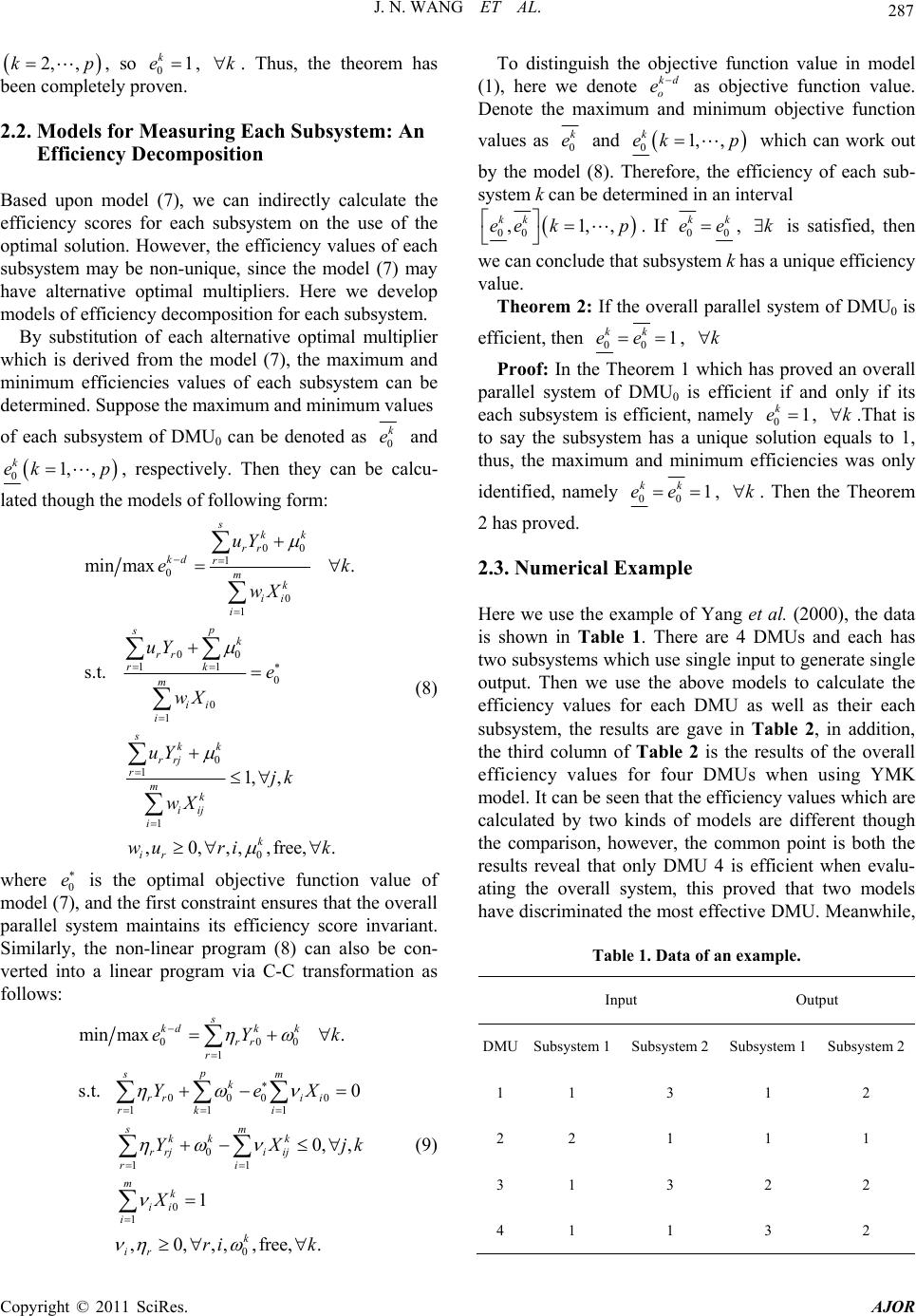 287 J. N. WANG ET AL. 2, ,kp, so 0, . Thus, the theorem has been completely proven. 1 k ek 2.2. Models for Measuring Each Subsystem: An Efficiency Decomposition Based upon model (7), we can indirectly calculate the efficiency scores for each subsystem on the use of the optimal solution. However, the efficiency values of each subsystem may be non-unique, since the model (7) may have alternative optimal multipliers. Here we develop models of efficiency decomposition for each subsystem. By substitution of each alternative optimal multiplier which is derived from the model (7), the maximum and minimum efficiencies values of each subsystem can be determined. Suppose the maximum and minimum values of each subsystem of DMU0 can be denoted as 0 k e and 01, , k ek p, respectively. Then they can be calcu- lated though the models of following form: 00 1 1 00 11 0 0 , , s rm i pk ii kk j ri 0 1 1 1 ax , 0, kd rr m i rr j m ii i ir uY wX uY wX wu 0 0 0 minm . s.t. 1,, ,free,. kk rr k ii s rk s r k k uY ek wX e jk k (8) where 0 is the optimal objective function value of model (7), and the first constraint ensures that the overall parallel system maintains its efficiency score invariant. Similarly, the non-linear program (8) can also be con- verted into a linear program via C-C transformation as follows: e 000 1 00 11 0 11 0 , , s r k sm kk ri eY Y ri 0 0 1 1 minma . s.t. 0 0,, 1 ,,free,. k k rr p sm i i i k i ij m i k k YeX Xjk k 0 x 0, kd rr rk rr j k ii ir X (9) To distinguish the objective function value in model (1), here we denote kd o e as objective function value. Denote the maximum and minimum objective function values as 0 k e and 01, , k ek p which can work out by the model (8). Therefore, the efficiency of each sub- system k can be determined in an interval 00 ,1,, kk ee kp . If 00 kk ee, is satisfied, then k we can conclude that subsystem k has a unique efficiency value. Theorem 2: If the overall parallel system of DMU0 is efficient, then 00 1 kk ee , k Proof: In the Theorem 1 which has proved an overall parallel system of DMU0 is efficient if and only if its each subsystem is efficient, namely 0, 1 k ek .That is to say the subsystem has a unique solution equals to 1, thus, the maximum and minimum efficiencies was only identified, namely 00 1 kk ee , . Then the Theorem k 2 has proved. 2.3. Numerical Example Here we use the example of Yang et al. (2000), the data is shown in Table 1. There are 4 DMUs and each has two subsystems which use single input to generate single output. Then we use the above models to calculate the efficiency values for each DMU as well as their each subsystem, the results are gave in Table 2, in addition, the third column of Table 2 is the results of the overall efficiency values for four DMUs when using YMK model. It can be seen that the efficiency values which are calculated by two kinds of models are different though the comparison, however, the common point is both the results reveal that only DMU 4 is efficient when evalu- ating the overall system, this proved that two models have discriminated the most effective DMU. Meanwhile, Table 1. Data of an example. Input Output DMUSubsystem 1Subsystem 2 Subsystem 1 Subsystem 2 1 1 3 1 2 2 2 1 1 1 3 1 3 2 2 4 1 1 3 2 Copyright © 2011 SciRes. AJOR  J. N. WANG ET AL. Copyright © 2011 SciRes. AJOR 288 Table 2. Efficiency values of the example. DMU The overall efficiency value (model 7) The overall efficiency value (YMK model) The efficiency value of subsystem 1 The efficiency value of subsystem 2 1 0.5 0.33 1 0.3333 2 0.6667 0.5 0.5 1 3 0.5 0.667 1 0.3333 4 1 1 1 1 based upon models of efficiency decomposition, each subsystem was proved that they have unique solution. The result of DMU 4 illustrates the Theorem 1 as it shows that the efficiency value of each subsystem is 1. In addition, for other three inefficient DMUs, only one of their subsystems is efficient, this brings about monolithic inefficient. Thus, taking internal structure of the DMU into consideration is necessary for efficiency evaluation of the overall system. Besides, take DMU 1 as an exam- ple, subsystem 2 is considered more important as the majority of the inputs are allocated to it, if we don not take the importance of subsystem 2 into consideration, the efficiency value of subsystem 2 is more than 0.3333. As subsystem 2 is non-effective, the decision maker should transfer some inputs to subsystem 1 for improv- ing the overall performance. 3. Application to Technological Innovation Organization of Each Region in China China has an increasing development in the area of tech- nology since the economic reform in 1978, and these technological activities have a great contribution to the economic growth and social development. However, each province in china demonstrated different efficien- cies in technological innovation activities. Zhong et al. (2010) utilize (DEA) models to evaluate the relative effi- ciencies of 30 regions in China, they indicated that tech- nological innovation development was unbalance in each region. In this paper, we believe that the major techno- logical innovation department of each province includes three portions: R & D (Research and Development) In- stitutions, Large & Medium-sized Enterprises and Insti- tutions of Higher Education. They were considered as a parallel structure as we described before. 3.1. Selection of Inputs and Outputs and Data Many different inputs and outputs indices were selected to evaluate the technological innovation activity. How- ever, it is well known that the discrimination power of DEA models will be much weakened if too many inputs or outputs indicators are used [17], we should chose the factors that can fully characterize the impact on the per- formance of technological innovation activity. Zhong [18] used R & D expenditure and Full-time equivalent of R & D personnel as inputs and Patent applications, the sales revenue of new products and the profit of primary busi- ness as outputs, nevertheless, according to Griliches [19], Ahuja and Katila [20], R & D expenditure and R & D personnel, Patent applications and the sales revenue of new products are the most important inputs and outputs of technological innovation activity, respectively. In this paper, the two kinds of core inputs, R & D expenditure and R & D personnel, were represent by Intramural Ex- penditure on R & D (: 1000 RMB$) and Full-time equi- valent of R & D (: man-year) personnel, respectively. The number of Patent granted (: item) is more appropri- ate to reflect the outputs of technological innovation ac- tivity, the sales revenue of new products (: 1000 RMB$), an index that directly measures product innovation, re- fers to the sales revenue achieved from sales of new products in the reporting year. Thus, we have two inputs and two outputs. The data we used are 30 regions of China in 2008 with an exception of Tibet, because of the missing statistical data. The data is obtained from the China Statistical Yearbook 2009 and China Statistical Yearbook on sci- ence and technology 2009. So we omited here. 3.2. Improvement with the Model Noted that data of outputs, we could not acquire the pre- cise outputs values to each organization in each province. Actually in China, the outputs of the technological inno- vation derive from the combination among these three organizations. However, in the daily management, each organization operated independently. The school com- mits itself to achieve theoretical innovation and break- through of key technologies, R & D institutions trans- form the scientific research achievements into products, the enterprise yields and sales the products and then gains profit. This indicated that the output of the techno- logical innovation is an outcome of three organizations. 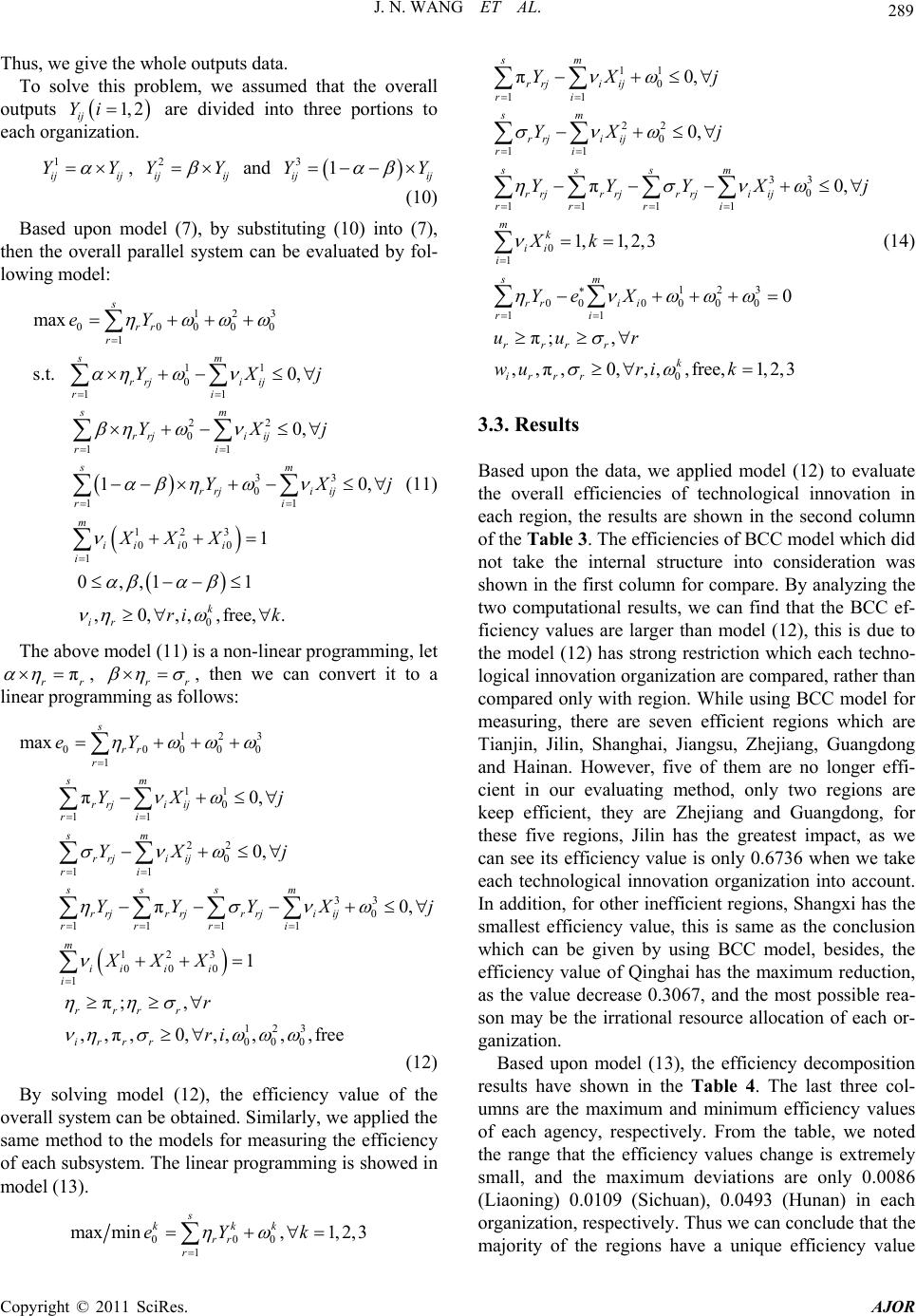 J. N. WANG ET AL. 289 Y j Thus, we give the whole outputs data. To solve this problem, we assumed that the overall outputs are divided into three portions to each organization. 1, 2 ij Yi 1 ij ij YY , and (10) 2 ij ij Y 31 ij ij YY Based upon model (7), by substituting (10) into (7), then the overall parallel system can be evaluated by fol- lowing model: 123 00000 1 11 0 11 22 0 11 33 0 11 123 000 1 max s.t. 0, 0, 10, 1 0,, s rr r sm rrji ij ri sm rrji ij ri sm rrjiij ri m iiii i eY YXj YXj YX XXX 0 11 ,0,,,,free,. k ir ri k (11) The above model (11) is a non-linear programming, let π rr , rr , then we can convert it to a linear programming as follows: 123 0000 0 1 11 0 11 22 0 11 33 0 11 1 1 123 000 1 max π0, 0, π0, 1 s rr r sm rrji ij ri sm rrji ij ri sssm rrjrrjrrji ij rrr i m ii i i i eY YX j YX j YYYX XXX 123 000 π;, ,,π,0,, ,,,,free rrrr irr r r ri j (12) By solving model (12), the efficiency value of the overall system can be obtained. Similarly, we applied the same method to the models for measuring the efficiency of each subsystem. The linear programming is showed in model (13). 000 1 maxmin,1, 2, 3 s kkk rr r eY k 11 0 11 22 0 11 33 0 11 11 0 1 123 000 0 00 11 π0, 0, π0, 1,1,2, 3 0 π;, ,,π, sm rrji ij ri sm rrji ij ri sssm rrjrrjrrji ij rrr i mk ii i sm rri i ri rrrr ir rr YX j YX j YYYX Xk Ye X uu r wu j 0 0,,,, free,1, 2,3 k ri k (14) 3.3. Results Based upon the data, we applied model (12) to evaluate the overall efficiencies of technological innovation in each region, the results are shown in the second column of the Table 3. The efficiencies of BCC model which did not take the internal structure into consideration was shown in the first column for compare. By analyzing the two computational results, we can find that the BCC ef- ficiency values are larger than model (12), this is due to the model (12) has strong restriction which each techno- logical innovation organization are compared, rather than compared only with region. While using BCC model for measuring, there are seven efficient regions which are Tianjin, Jilin, Shanghai, Jiangsu, Zhejiang, Guangdong and Hainan. However, five of them are no longer effi- cient in our evaluating method, only two regions are keep efficient, they are Zhejiang and Guangdong, for these five regions, Jilin has the greatest impact, as we can see its efficiency value is only 0.6736 when we take each technological innovation organization into account. In addition, for other inefficient regions, Shangxi has the smallest efficiency value, this is same as the conclusion which can be given by using BCC model, besides, the efficiency value of Qinghai has the maximum reduction, as the value decrease 0.3067, and the most possible rea- son may be the irrational resource allocation of each or- ganization. Based upon model (13), the efficiency decomposition results have shown in the Table 4. The last three col- umns are the maximum and minimum efficiency values of each agency, respectively. From the table, we noted the range that the efficiency values change is extremely small, and the maximum deviations are only 0.0086 (Liaoning) 0.0109 (Sichuan), 0.0493 (Hunan) in each organization, respectively. Thus we can conclude that the ajority of the regions have a unique efficiency value m Copyright © 2011 SciRes. AJOR 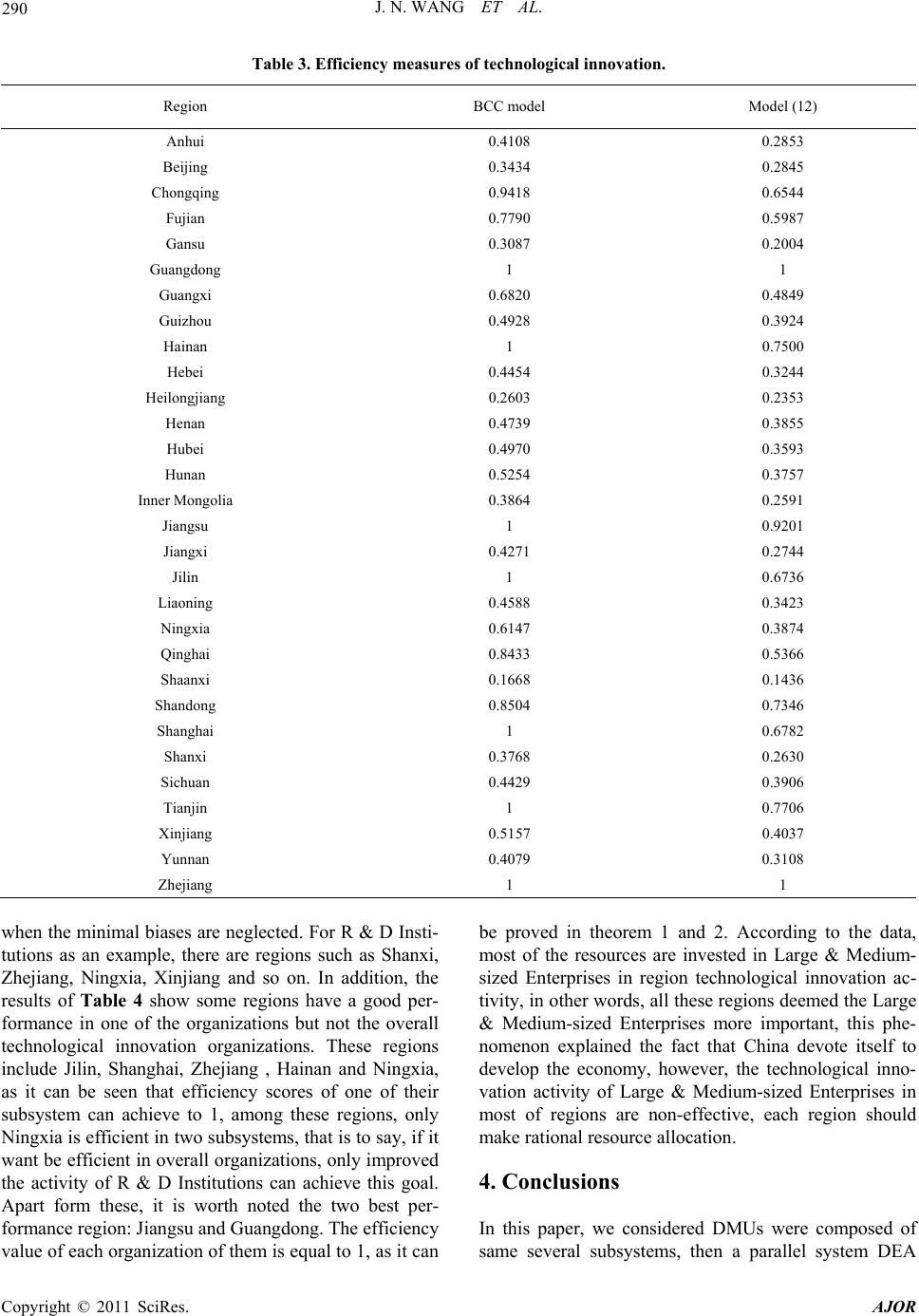 J. N. WANG ET AL. Copyright © 2011 SciRes. AJOR 290 Table 3. Efficiency measures of technological innovation. Region BCC model Model (12) Anhui 0.4108 0.2853 Beijing 0.3434 0.2845 Chongqing 0.9418 0.6544 Fujian 0.7790 0.5987 Gansu 0.3087 0.2004 Guangdong 1 1 Guangxi 0.6820 0.4849 Guizhou 0.4928 0.3924 Hainan 1 0.7500 Hebei 0.4454 0.3244 Heilongjiang 0.2603 0.2353 Henan 0.4739 0.3855 Hubei 0.4970 0.3593 Hunan 0.5254 0.3757 Inner Mongolia 0.3864 0.2591 Jiangsu 1 0.9201 Jiangxi 0.4271 0.2744 Jilin 1 0.6736 Liaoning 0.4588 0.3423 Ningxia 0.6147 0.3874 Qinghai 0.8433 0.5366 Shaanxi 0.1668 0.1436 Shandong 0.8504 0.7346 Shanghai 1 0.6782 Shanxi 0.3768 0.2630 Sichuan 0.4429 0.3906 Tianjin 1 0.7706 Xinjiang 0.5157 0.4037 Yunnan 0.4079 0.3108 Zhejiang 1 1 when the minimal biases are neglected. For R & D Insti- tutions as an example, there are regions such as Shanxi, Zhejiang, Ningxia, Xinjiang and so on. In addition, the results of Table 4 show some regions have a good per- formance in one of the organizations but not the overall technological innovation organizations. These regions include Jilin, Shanghai, Zhejiang , Hainan and Ningxia, as it can be seen that efficiency scores of one of their subsystem can achieve to 1, among these regions, only Ningxia is efficient in two subsystems, that is to say, if it want be efficient in overall organizations, only improved the activity of R & D Institutions can achieve this goal. Apart form these, it is worth noted the two best per- formance region: Jiangsu and Guangdong. The efficiency value of each organization of them is equal to 1, as it can be proved in theorem 1 and 2. According to the data, most of the resources are invested in Large & Medium- sized Enterprises in region technological innovation ac- tivity, in other words, all these regions deemed the Large & Medium-sized Enterprises more important, this phe- nomenon explained the fact that China devote itself to develop the economy, however, the technological inno- vation activity of Large & Medium-sized Enterprises in most of regions are non-effective, each region should make rational resource allocation. 4. Conclusions In this paper, we considered DMUs were composed of same several subsystems, then a parallel system DEA 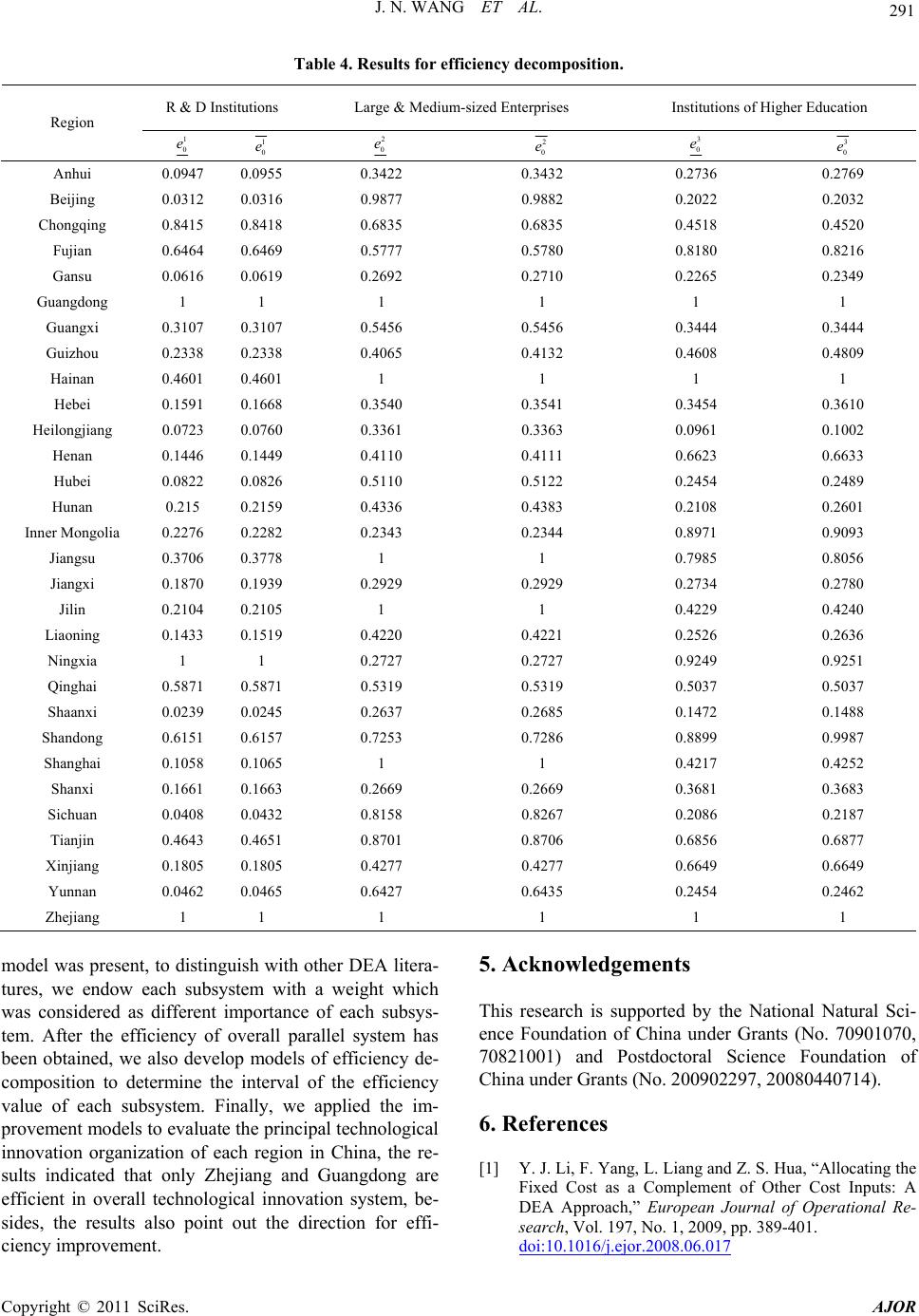 291 J. N. WANG ET AL. Table 4. Results for efficiency decomposition. R & D Institutions Large & Medium-sized Enterprises Institutions of Higher Education Region 1 0 e 1 0 e 2 0 e 2 0 e 3 0 e 3 0 e Anhui 0.0947 0.0955 0.3422 0.3432 0.2736 0.2769 Beijing 0.0312 0.0316 0.9877 0.9882 0.2022 0.2032 Chongqing 0.8415 0.8418 0.6835 0.6835 0.4518 0.4520 Fujian 0.6464 0.6469 0.5777 0.5780 0.8180 0.8216 Gansu 0.0616 0.0619 0.2692 0.2710 0.2265 0.2349 Guangdong 1 1 1 1 1 1 Guangxi 0.3107 0.3107 0.5456 0.5456 0.3444 0.3444 Guizhou 0.2338 0.2338 0.4065 0.4132 0.4608 0.4809 Hainan 0.4601 0.4601 1 1 1 1 Hebei 0.1591 0.1668 0.3540 0.3541 0.3454 0.3610 Heilongjiang 0.0723 0.0760 0.3361 0.3363 0.0961 0.1002 Henan 0.1446 0.1449 0.4110 0.4111 0.6623 0.6633 Hubei 0.0822 0.0826 0.5110 0.5122 0.2454 0.2489 Hunan 0.215 0.2159 0.4336 0.4383 0.2108 0.2601 Inner Mongolia 0.2276 0.2282 0.2343 0.2344 0.8971 0.9093 Jiangsu 0.3706 0.3778 1 1 0.7985 0.8056 Jiangxi 0.1870 0.1939 0.2929 0.2929 0.2734 0.2780 Jilin 0.2104 0.2105 1 1 0.4229 0.4240 Liaoning 0.1433 0.1519 0.4220 0.4221 0.2526 0.2636 Ningxia 1 1 0.2727 0.2727 0.9249 0.9251 Qinghai 0.5871 0.5871 0.5319 0.5319 0.5037 0.5037 Shaanxi 0.0239 0.0245 0.2637 0.2685 0.1472 0.1488 Shandong 0.6151 0.6157 0.7253 0.7286 0.8899 0.9987 Shanghai 0.1058 0.1065 1 1 0.4217 0.4252 Shanxi 0.1661 0.1663 0.2669 0.2669 0.3681 0.3683 Sichuan 0.0408 0.0432 0.8158 0.8267 0.2086 0.2187 Tianjin 0.4643 0.4651 0.8701 0.8706 0.6856 0.6877 Xinjiang 0.1805 0.1805 0.4277 0.4277 0.6649 0.6649 Yunnan 0.0462 0.0465 0.6427 0.6435 0.2454 0.2462 Zhejiang 1 1 1 1 1 1 model was present, to distinguish with other DEA litera- tures, we endow each subsystem with a weight which was considered as different importance of each subsys- tem. After the efficiency of overall parallel system has been obtained, we also develop models of efficiency de- composition to determine the interval of the efficiency value of each subsystem. Finally, we applied the im- provement models to evaluate the principal technological innovation organization of each region in China, the re- sults indicated that only Zhejiang and Guangdong are efficient in overall technological innovation system, be- sides, the results also point out the direction for effi- ciency improvement. 5. Acknowledgements This research is supported by the National Natural Sci- ence Foundation of China under Grants (No. 70901070, 70821001) and Postdoctoral Science Foundation of China under Grants (No. 200902297, 20080440714). 6. References [1] Y. J. Li, F. Yang, L. Liang and Z. S. Hua, “Allocating the Fixed Cost as a Complement of Other Cost Inputs: A DEA Approach,” European Journal of Operational Re- search, Vol. 197, No. 1, 2009, pp. 389-401. doi:10.1016/j.ejor.2008.06.017 Copyright © 2011 SciRes. AJOR 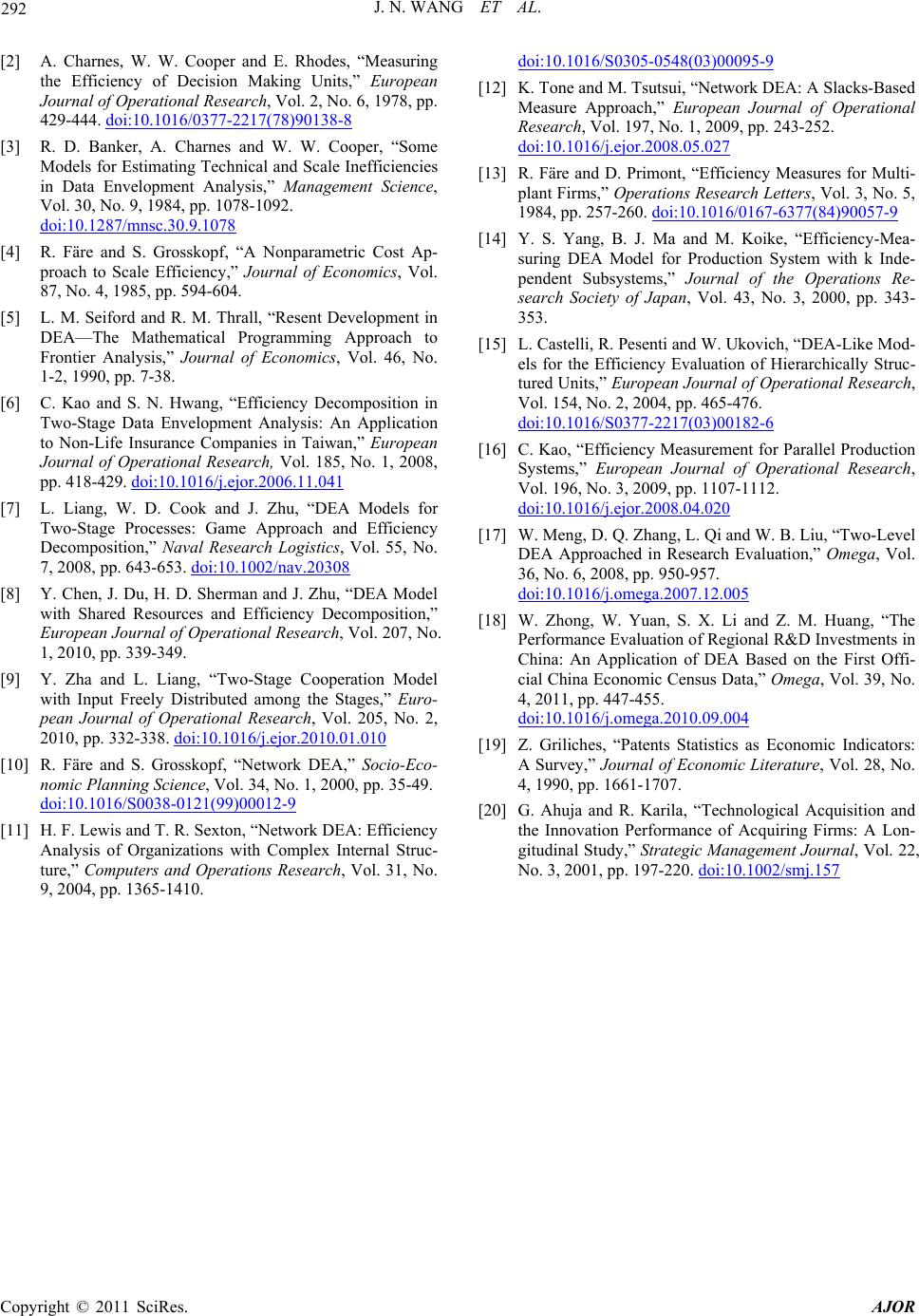 J. N. WANG ET AL. 292 [2] A. Charnes, W. W. Cooper and E. Rhodes, “Measuring the Efficiency of Decision Making Units,” European Journal of Operational Research, Vol. 2, No. 6, 1978, pp. 429-444. doi:10.1016/0377-2217(78)90138-8 [3] R. D. Banker, A. Charnes and W. W. Cooper, “Some Models for Estimating Technical and Scale Inefficiencies in Data Envelopment Analysis,” Management Science, Vol. 30, No. 9, 1984, pp. 1078-1092. doi:10.1287/mnsc.30.9.1078 [4] R. Färe and S. Grosskopf, “A Nonparametric Cost Ap- proach to Scale Efficiency,” Journal of Economics, Vol. 87, No. 4, 1985, pp. 594-604. [5] L. M. Seiford and R. M. Thrall, “Resent Development in DEA—The Mathematical Programming Approach to Frontier Analysis,” Journal of Economics, Vol. 46, No. 1-2, 1990, pp. 7-38. [6] C. Kao and S. N. Hwang, “Efficiency Decomposition in Two-Stage Data Envelopment Analysis: An Application to Non-Life Insurance Companies in Taiwan,” European Journal of Operational Research, Vol. 185, No. 1, 2008, pp. 418-429. doi:10.1016/j.ejor.2006.11.041 [7] L. Liang, W. D. Cook and J. Zhu, “DEA Models for Two-Stage Processes: Game Approach and Efficiency Decomposition,” Naval Research Logistics, Vol. 55, No. 7, 2008, pp. 643-653. doi:10.1002/nav.20308 [8] Y. Chen, J. Du, H. D. Sherman and J. Zhu, “DEA Model with Shared Resources and Efficiency Decomposition,” European Journal of Operational Research, Vol. 207, No. 1, 2010, pp. 339-349. [9] Y. Zha and L. Liang, “Two-Stage Cooperation Model with Input Freely Distributed among the Stages,” Euro- pean Journal of Operational Research, Vol. 205, No. 2, 2010, pp. 332-338. doi:10.1016/j.ejor.2010.01.010 [10] R. Färe and S. Grosskopf, “Network DEA,” Socio-Eco- nomic Planning Science, Vol. 34, No. 1, 2000, pp. 35-49. doi:10.1016/S0038-0121(99)00012-9 [11] H. F. Lewis and T. R. Sexton, “Network DEA: Efficiency Analysis of Organizations with Complex Internal Struc- ture,” Computers and Operations Research, Vol. 31, No. 9, 2004, pp. 1365-1410. doi:10.1016/S0305-0548(03)00095-9 [12] K. Tone and M. Tsutsui, “Network DEA: A Slacks-Based Measure Approach,” European Journal of Operational Research, Vol. 197, No. 1, 2009, pp. 243-252. doi:10.1016/j.ejor.2008.05.027 [13] R. Färe and D. Primont, “Efficiency Measures for Multi- plant Firms,” Operations Research Letters, Vol. 3, No. 5, 1984, pp. 257-260. doi:10.1016/0167-6377(84)90057-9 [14] Y. S. Yang, B. J. Ma and M. Koike, “Efficiency-Mea- suring DEA Model for Production System with k Inde- pendent Subsystems,” Journal of the Operations Re- search Society of Japan, Vol. 43, No. 3, 2000, pp. 343- 353. [15] L. Castelli, R. Pesenti and W. Ukovich, “DEA-Like Mod- els for the Efficiency Evaluation of Hierarchically Struc- tured Units,” European Journal of Operational Research, Vol. 154, No. 2, 2004, pp. 465-476. doi:10.1016/S0377-2217(03)00182-6 [16] C. Kao, “Efficiency Measurement for Parallel Production Systems,” European Journal of Operational Research, Vol. 196, No. 3, 2009, pp. 1107-1112. doi:10.1016/j.ejor.2008.04.020 [17] W. Meng, D. Q. Zhang, L. Qi and W. B. Liu, “Two-Level DEA Approached in Research Evaluation,” Omega, Vol. 36, No. 6, 2008, pp. 950-957. doi:10.1016/j.omega.2007.12.005 [18] W. Zhong, W. Yuan, S. X. Li and Z. M. Huang, “The Performance Evaluation of Regional R&D Investments in China: An Application of DEA Based on the First Offi- cial China Economic Census Data,” Omega, Vol. 39, No. 4, 2011, pp. 447-455. doi:10.1016/j.omega.2010.09.004 [19] Z. Griliches, “Patents Statistics as Economic Indicators: A Survey,” Journal of Economic Literature, Vol. 28, No. 4, 1990, pp. 1661-1707. [20] G. Ahuja and R. Karila, “Technological Acquisition and the Innovation Performance of Acquiring Firms: A Lon- gitudinal Study,” Strategic Management Journal, Vol. 22, No. 3, 2001, pp. 197-220. doi:10.1002/smj.157 Copyright © 2011 SciRes. AJOR
|